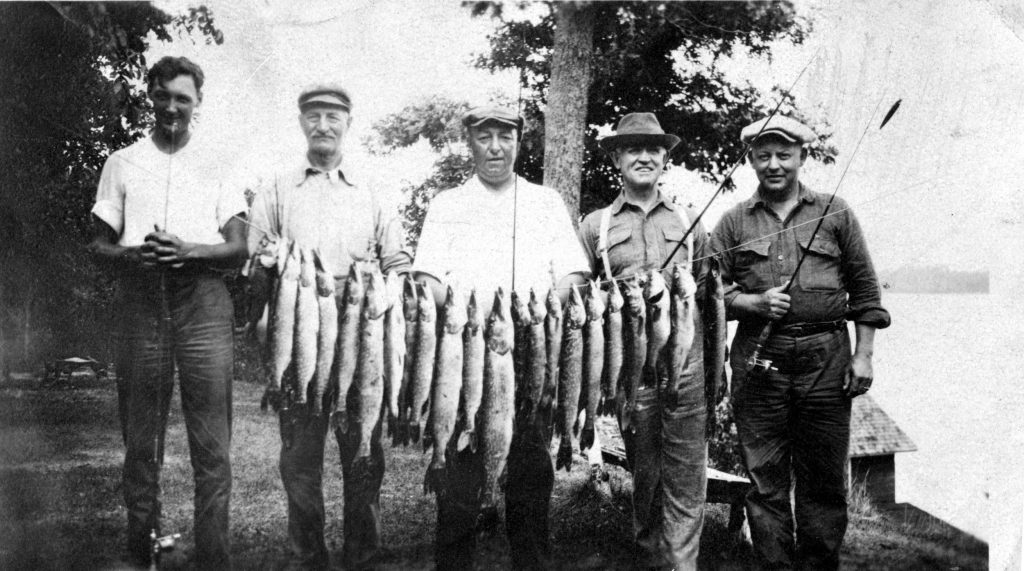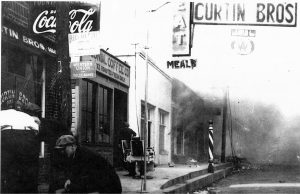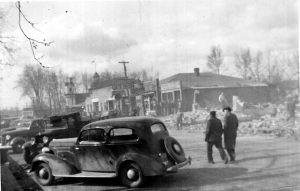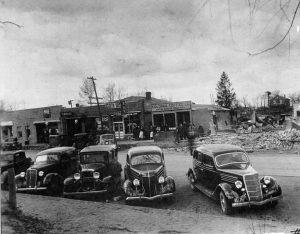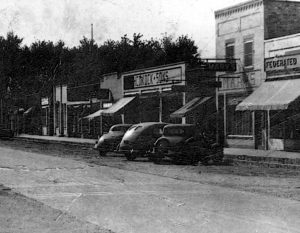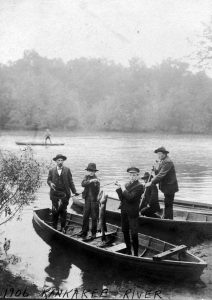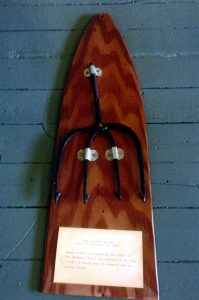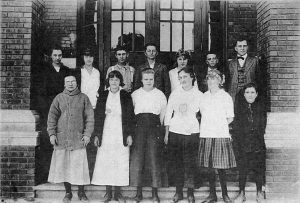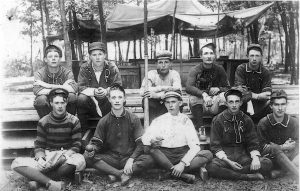THE SETTLING OF THE GRAND MARSH OF THE KANKAKEE
RIVER
Interviewed by Laverne Terpstra – April 2, 1996
Trnascribed by Flo Riley-April 10, 1996
John Wayne Oliver
I was born in DeMotte way back in February 9, 1922. I’ve lived in this community practically all my life except for three years spent in Hebron and three years spent in the Army.
Talking about the fire, well I was in the library there at the high school (1000 Halleck SW). Looking out the window I saw a trash fire in back of Mary’s Restaurant (816 S. Halleck), and in the vicinity of Konovsky’s Lumber Yard (809 Almond SW). It was a very windy day and I couldn’t figure out why anybody would burn trash then. It wasn’t long before more of it came, more and more. Everybody was getting excited then. It wasn’t long before they dismissed school. They wanted to get people out of town. Some of us didn’t go out of town and directly we went up and did what we could to vacate some of the stores. My golly, what a mess. Black clouds, but then it could have been worse. If we’d have had the fire department then like we do now well, I don’t think a lot of that would have happened. It sure has been a change from what it was then on some of those buildings. Some of those old buildings, they were old, old landmarks such as one I heard was the original saloon in DeMotte. One was a converted ice house back there and there might have been another one or two, but I can’t remember.
One thing I can remember about the fire is going through the rubble afterwards in some of those stores, especially that Green Gables filling station which laid north of the railroad tracks where Rudy Zylstra’s building is now (713 Halleck St. SE). We’d go through there where they had slot machines and we’d pick up a few nickels now and then. Every day for weeks we would go through that same rubble and find those stray nickels that were in there. Then up town, in most of those buildings and they kept us shagged out of there because there were part basements under some of them and they were afraid we’d get hurt.
I remember that John Deere place there, Ott DeYoung had just built the next two buildings just south of 820 S. Halleck there, and I don’t think they were six months old before they got burned down. Then they rebuilt them just exactly like they were the first time and I can still remember two old men plastering. The same guys plastered the second time that had plastered the first time. It amazed me and a lot of other people how that fire got stopped right there by Cheevers (834 S. Halleck) there on those old buildings and still got a couple of houses clear on the east end of town. I can remember the McGuinness place (10th & Begonia), and it seemed like there was another place down there burned down just by the embers that blew down there with the wind. Then it let the wooden buildings there where the fire was.
Afterward DeKock’s had their store right where Fagen has his hospital supplies now. I can’t remember if Billy Swart or any of them had a store. I don’t think they did, things that happened in 1936-37, things escape a persons mind. They might come later.
It runs in my mind that on the east side of the street after the fire, the hotel (corner of 231 & 8th St.), Konovsky’s house and the bank. There were several buildings on further south, between there and Neil Sekema’s garage, went up in flames. I can just remember that old John Bunning had an insurance place, a notary public and Jake Boonstra had a shoe shop, and it runs in my mind there was a restaurant and bakery there, that part might by a little fuzzy. I know Pop Rowen had a bakery there, but it seems to me he had a little coffee shop in with that, but I’, not quite sure on that. I can remember it was all wiped out between the bank and Neil Sekema’s garage. And of course, Cheever’s house (833 S. Halleck) on the corner, it was saved too, for some unknown reason, but the fire jumped on east of there about a block. There might have been another one in here that I can’t remember.
I can remember back when I was just a little kid, Cheever, old Caleb Cheever, he had a blacksmith shop which would have been in the southwest corner of the present Cheever’s building (834 S. Halleck). That was back in the days of Model T’s and the buggy days, he still did that. And then he built that store in front and worked his way north until the restaurant, Curtin’s Restaurant (915 S. Halleck), that was the last part of it. Curtins’ had that restaurant, if I remember right, for twenty-seven years.
Then it changed hands four or five times after that. I can’t exactly remember when they closed that finally, but it runs in my mind it must have been in the ‘70s or ‘80s.
As far as fire departments, Hebron was the first one, then Crown Point, Valparaiso, Lake Village, Lowell and there were more. There were seven or eight fire departments responded and I can’t remember where some of them came from. I can still see Hebron coming down the road there. They were reaching for their hats and boots when they passed our homestead (341 Halleck).
I can remember, maybe three or four days or whatever, to clean up all the rubble from that town fire. Then they started rebuilding right away. Otto DeYoung had stores just built, I don’t think he was in them over a month or two when the fire came. He had to rebuild them again and the second time around he built them exactly like they were the first time as far as I can remember. How long it took to rebuild the town, I can’t remember, but I think a lot of it was done before the first winter. I can’t remember going into the second one.
Talking about hunting and fishing during the early days there, I can remember during the depression that we had rabbits and sometimes we had as high as forty and fifty rabbits hung up on the north side of the house, hanging on the clothes line. In fact, we just practically lived on rabbits back then. And then in my later years I got so I couldn’t eat rabbit on account of remembering eating so many during the depression. We would have all them hanging up there and eating them all winter and then when it started getting warm, my mother canned them so then we ate them all summer. That was enough of the rabbits. Then in the spring we would go out and spear carp and sometimes we would spear a boat load of them. At that time we could go down and around town and give them away, each and everyone of them away, and if we were lucky sometimes we could sell a few. But now I wouldn’t know who I could even give a half a dozen carp to. Some of them might take them if you cleaned them, but otherwise the majority of them say they’re not fit to eat. And I can remember back then a lot of people were glad to get them. And there we would go out in these flood waters of the Kankakee and the Hodge Ditch, they didn’t have their banks built up like they do now. So, in the spring that whole countryside would flood out so a few of us would go out there and spear carp at night, sometimes in the day time. That went on until, some of those places I can remember, up until the early ‘50s they would do that. But since then that’s all died out.
Some of the guys back then, you read about how the duck hunting was back then in them days. In my early days I can remember we would go out and there would be a lot of ducks and sometimes bunches when they would go over, they would sort of blacken the sky. You don’t see them anymore. But I believe there are more geese come through here now than there ever was before, but them ducks, they just plumb disappeared. I hate to say it, but the ‘good old days’ I think, are gone forever when it comes to hunting ducks and rabbits. I wouldn’t know where to go to shoot a rabbit out here in the marsh. You would think there was a lot of that stuff but there absolutely isn’t any, nowhere.
That’s got to do with the farmers changing their way, they broke up more ground. There used to be a lot of little brush patches all over, you don’t see that anymore. You have a lot of blacktop road where you used to have all dirt roads or roads didn’t exist at all. Let’s face it, there’s more people today so when you get more people, less animals and then you have tractors, some of them animals can’t get away from them tractors. I can look out here and see them burning and that will destroy a few early rabbit’s nests right there if there was any and things like that. They call that progress.
When I was a kid and a lot of growing up, in the spring of the year we’d go bullhead fishing. We’d go to some of these local ditches, most anyplace we’d go out and catch us a mess of bullheads and once in awhile there would be a dogfish caught or something like that. You didn’t have gas lanterns, too poor to have them, so we’d take an old tire or something and build us a fire to keep the mosquitoes away and we’d catch bullheads, in fact we’d catch quite a few nice bullheads. Today, I don’t know why, but you can go to those same ditches and you can’t catch anything. If you do they’re not big enough to eat or you’d never catch enough. What happened to them I really don’t know because I have an idea it’s a factor of several things, but that’s another progress. In other words, the bullheads and other nice fish have left these ditches. There used to be what they called “Sekie” or Sekema Ditch on the west of town. I can remember as a kid just going down there and it seemed to me like Otto DeYoung, Maurie Cheever, they used to spear suckers underneath the old railroad bridge. Hang up lights there and spear some suckers. Now suckers don’t come up that ditch in the spring that I know of. That’s another sign of the times that just went bye-bye.
It seems like every spring they would have what you would call a sucker run. The fish, the suckers, they would come up from the river and hit these ditches like the “Sekie” Ditch, which eventually would run into another ditch and hit into the river so them suckers would come up that way and the guys would have to get in on the suckers run. You could catch them with hook and line but mostly they speared them. And them suckers, they usually ran from one to five or six, once in awhile you’d get a big one, and they would go seven or eight pounds. They were a bony fish, but by golly, they were a sweet tasting fish and they were an early fish in the spring and a lot of people really loved to eat them. I still eat them if I can get them. But now them sucker runs as far as I know, they don’t exist anymore, so that’s another thing that just went bye-bye.
Then I can remember one incident in the history, that I didn’t see, that was told by a good friend of mine. Jay Spencer was telling that his father-in-law, Frank Hart and Luther Frame, they laid up the road south of town (state road 10), the roadbed between DeMotte and what they called the Dutch Ridges, which is about two miles south of DeMotte. They used a team of oxen to pull their plow to put that roadbed in, the original bed through that spot. Then the road turned west down over the ridges and eventually hit the high spots between there and Momence, Illinois. They say if you go down the ridges in places you can see that old wagon rut down through there. I’ve never looked at it myself, but they claim at places that’s still in evidence down there. And he also told me that times a lot of people think the Kankakee Marsh didn’t go very far south, but at one time it went clear as far as Virgie. He can remember the times you could go to Dutch Ridges and go from there to Virgie by just stepping from rat house to muskrat house all the way down to Virgie (700 W 700 N). So you look at that now and I don’t think it’s possible, but that was all low ground through there, and that’s the way it was back then at the turn off the century.
I can remember back to tales of my grandfather, Sam Obbenchain, which was a real early settler out here. Said that every spring him and my two uncles would go out in the marsh and they would literally spear a whole wagonload of carp. Then he’d go to his icehouse where he had ice put up and ice them down and take them with a team of horses and head south and he would hit down as far as Medaryville and Francesville peddling fish all the way down that way. He’d be gone two or three days until he got rid of a whole load of carp. He’d come back with enough groceries to last his family and some of the neighbors for several months from that load of carp. But how many years he did that, I know it amounted to several years. I can remember my wife remembering her mother down in Gifford buying carp off of my grandfather back then. That was in the early twenties or late teens. I don’t know how long it lasted but it was then.
I can remember that in my younger years, the way some of this marshland got cleared, the different people in town. If they wanted to put out what they called a ‘truck patch’ which was actually a pickle patch or potato patch, they could come out here in this marsh ground and clear them off an acre or two, whichever they could handle and they got free rent just for clearing it off. This was some nice marsh ground and if we had a dry year and didn’t flood out they got a bountiful crop off of it and it also helped the farmer that owned the land. That is the way a lot of this marsh ground got cleared off.
Back around 1960 and in through there, there was quite a few fox in this county and probably before that. I can remember I got interested and a few other guys got interested and they chased foxes all winter with their dogs. Some of them had dogs and others just walked them down. I got so I was trapping them. A man showed me how to catch them. I caught as high as, one year, up to fifty fox in one season within two miles of town here. But then they kept going down and down later on and I haven’t trapped a fox or even attempted to in the last several years for the simple reason thirty years ago we never had a coyote round here. Now the coyotes have practically annihilated the fox. A coyote is an awful big animal so they are awful hard on a lot of this game. Another thing back then we didn’t have deer. I can remember the first deer I seen to come in here was in 1938. We had one deer and where in came from……I never saw another deer for probably twenty years. It just passed through. Now we have wild turkeys. A few of them started and that’s something I can’t remember my grandparents or any of them talking about turrkeys. If there were any back then I never heard about it. That might be a new species for all I know. They would talk about quail but that’s something we’ve got just a few. I cam remember as a kid living in town, I’d go out quail hunting and I’d see eight or ten coveys a day. I wouldn’t know where to find one covey today. I think a lot of that’s got to do with the change of farming. Back then practically every farm had a little brush patch here or a little hill there that was covered with brush and trees. Ditch banks were never cut down or burned off or anything. One thing we just do not have the habitat for that stuff like we did then. If they’ll ever come back, I don’t think so. Not the small stuff because it can’t survive. They might get some new species like the turkeys got started. And then I hear some places they have grouse, but not right here. At the game preserves and other places south. Some places they got too many deer and some places they’re bothered with beaver. There are a few beaver now in the river but awhile back, twenty years ago, every ditch had beaver in it but they had the habit of putting their dams in the wrong places and they had to be annihilated. But like I said, we have a few in the river and the bigger ditches have got beaver and that’s just about enough of them. I’m hopeful, probably not in my time, to see some new species of animals and birds come here because what would the country be if it didn’t have a bird or an animal. If it gets that way I’d just as soon I was old enough to pass on then. Then some people just call it progress. I’ve got another name for it.
One time in my early years and again don’t ask what year it was, but they had a bandstand there in town. One night a week we had free band concerts up there on the east side of the street (231). The only two people that runs in my mind that I can remember in the band at that time was Bud Henrichs and Jay Spencer. Bud played a coronet and Jay played drums. Incidentally, Jay couldn’t read a note of the music, and he still played the drums in the band. I remember that. And that it seems to me like on two different summers they would have a free movie there on a Wednesday night in that same place. It might have lasted longer than, but I can only remember two years. People would come to town with their families to get groceries, etc. This was their entertainment for young people. I don’t think they got into as much trouble as they do now, but one thing they didn’t have was transportation. If we had transportation back then we would have gotten into as much devilment as today. We just didn’t have no way of doing it and there wasn’t near as many of us. But then one night a month they had, if I remember right, what we called a community meeting at the school. They’d have home talent night one time and they had different kinds of entertainment. Once in awhile an orchestra from some other school would come or some guys would put on a little skit. Some of them were awful comical, we thought, but I reckon by todays standards they’d be awful boring. then in later years they had a portable skating rink that would come into town. It was set up north of the tracks just past where Zylstra has his place (713 Halleck St. SE). How long that lasted, I don’t know. It seems to me like John Koster put up a tent skating rink first where Walstra Fertilizer is located and later built a building in the same spot (832 E. 15th St., south side of 231), he operated a skating rink there. Jake Heilema somehow or another, he got the idea and he went up north and he had a skating rink. As far as I know he might still have. I really don’t know. Outside of that there wasn’t much to do, then you have ball games there in the wintertime. That was it. They couldn’t have too much. If you lived too far away from town you couldn’t go there anyway, you didn’t have no way of going. Folks would come there on a Saturday night and do their trading and sometimes in the summertime they’d get there on Wednesday night, otherwise you would make your own play or whatever at home. Neighbors would get together and have some ball games out in the pasture or whatever. We just didn’t have the entertainment back there. And then in the wintertime, I remember kids would get together when these ditches would freeze up and we’d go ice skating on ditches. We’d get several together and have a hockey game. Hockey pucks then was tin cans and we’d cut us a hockey stick out of the nearest woods. We had as much fun back then with some banged up shins and that but that’s what I remember doing in the wintertime. We didn’t have hardly any hills to slide on.
I can remember one time in 1936 the road between here and Hebron was solid ice. They didn’t have ways of taking it off. Some of us kids put on our ice skates and skated right down the road to Hebron. We’d go to the show, come out of the show and put our skates on and skate back to DeMotte. How times have changed on that. As far as traffic, there wasn’t any. That’s how we did it back then.
Back when I was a kid, I can remember on the Chicago and Wabash Railroad, which a lot of people know as the Gifford Railroad, one time it ran from Pleasant Ridge up to Dinwiddie (near Lowell on Road 2). That’s as far as it got. The man who built it at that time was named Gifford, he formed the town of Gifford and had it plotted out and he owned land up in Kersey (231 north on 600), in fact he owned quite a bit through there. His original idea of the railroad was supposed to go from Monon or somewhere down there up into Chicago. But he just started forty years too late. He just started that section and just had that done and then on the south end of Pleasant Ridge he wanted to hook in onto the Monon and they wouldn’t let him hook in onto it. They wouldn’t allow that because that was competition for them, so he ran out of money and that line just operated there for a short distance for a number of years, a short number of years.
I can remember north of town at the place that we call the Potter Farm they used to have a ball diamond there, where Harry DeYoung lives there now (14601 North Us Hwy. 231). Along the road there’s a ball diamond and every Sunday they’d have a ball game there, different towns. I remember when the boys from Gifford there and part of their fans club would come up from Gifford on the old handcar (tracks just north of 14100 North US Hwy. 231). They’d put the handcar up there and play their ball
game and then get on the handcar and pump it on back to Gifford.
That was back in when they started tearing out the track and later when they came taking the bridge out across the river. I can remember they all joked around, they brought Roy Odle who had that famous wrecker on his which could move about anything, they always said he pulled the river out of shape when he was trying to pull the bridge out of the river. You can go along there and part of the places that old Gifford track is all dissolved into farmland, but then a few places it still exists. There are a lot of people around town who don’t even know that existed or where it went or why. The same way, there’s a railroad south of town that hit Fair Oaks and across there and where that went from I don’t know really know. I can remember that. That operated up until about the time of the war, I think. At one time it picked up the milk and eggs of the farmers down there at Fair Oaks, Virgie and around through there and took it to the Chicago market. Just when that was disbanded exactly I can’t even tell you. What we call the Gifford Line, was originally the Chicago Wabash, in fact originally it only went from Dinwiddie on the north to Pleasant Ridge (east of Rensselaer on Road 14), on the south and Dinwiddie lies on Route 2 just about I would say a mile or somewhere in there west of I-65. You’ll see a little cemetery there and the sign I think is still there along the road that says Dinwiddie (near Lowell). The Gifford track ended there just a few yards north of Route 2 and then down there at Pleasant Ridge at one time there where he started to build an overpass over another railroad is where it ended down there. But I don’t know whether that overpass is still there or not. And then another railroad, that comes to my mind, south of town we called “The Old Coalie”. I can’t remember what it’s destination was or where it went. All I can know, it went from Kniman on down around through Pembroke, around Fair Oaks and through there and swung up and it seems to me like it went over towards Momence but I don’t want to be quoted on that. Just where it went that way I do not know. At one time the New York Central which is Conrail I guess, goes through DeMotte. The New York Central went at one time from Kankakee over to Elkhart. During the early thirties it had one diesel train on it, one car, a passenger car and a mail car, and you could set your watch from the time that mail train would get there in the afternoon. It runs in my mind there was just one trip through there. I know some of the schoolteachers here was to give their kids something that they never did. They would take some of their class and put them on the train here in DeMotte and have dad pick them up over there in Shelby. Tales to tell they got to ride on the train. I can’t even tell exactly when that mail train was discontinued. It seems to me that was right during the war, but I might be wrong there. Now they’ve got this Conrail track, it only goes as far as Wheatfield to the NIPSCO plant and if it wasn’t for the NIPSCO plant it wouldn’t even go that far cause it’s tore up all the way east because they don’t use it anymore. They just use it now to haul one or two trainloads of coal to NIPSCO. Otherwise that would end that railroad. That’s about all I can tell you about the railroads in this part of the country.
This concludes the interview with J. Wayne Oliver.


